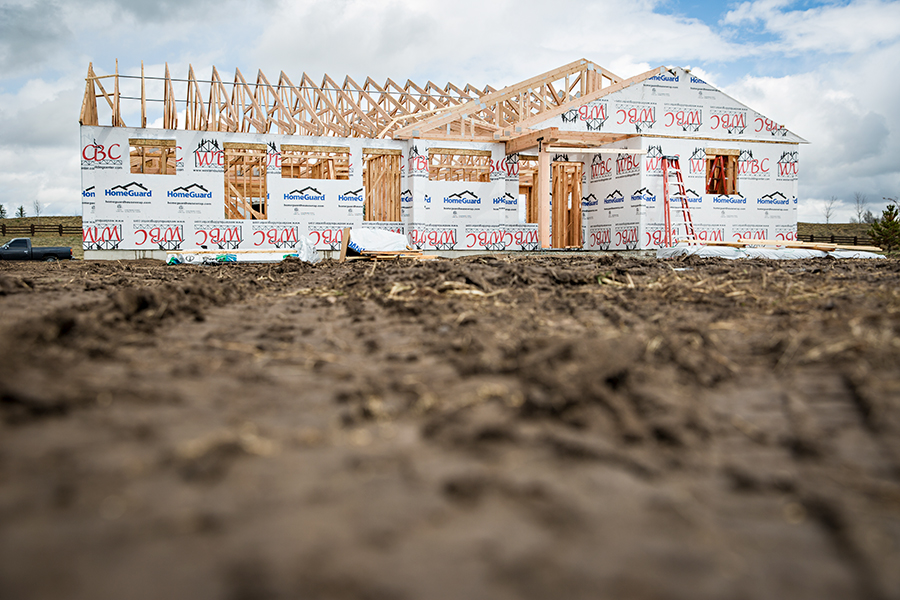Building in the Flathead ‘Takes a Breather’
Construction in the county has slowed down since its pandemic peak, but each municipality faces its own challenges as the residential and commercial development momentum eases
By Maggie Dresser
During the height of the pandemic when a slew of new residents landed in the Flathead Valley and mortgage rates fell below 3%, construction demand skyrocketed. Kalispell approved roughly 900 new residential units in 2021 and Whitefish issued permits for almost 300 units in 2020. Commercial projects in Columbia Falls led to $37 million in value by the end of 2021.
Three years since the pandemic building boom began, city managers in the Flathead Valley say demand remains strong, but it’s begun to cool.
Last year, Kalispell issued permits for about 700 units, compared to about 400 units in 2019.
“We definitely had that peak in ’21,” Kalispell City Manager Doug Russell said at the Kalispell Chamber of Commerce Growth Summit on April 12. “We had a lot of big multifamily projects that started in ’21 and are being built in 2022 … However, there’s no doubt we are seeing a cooling of the residential industry.”
Officials point to labor shortages, supply chain disruptions and a rise in interest rates as contributing factors. But developers also say the pandemic caused some burnout among the industry.
“It was a free for all,” Compass Construction owner Bill Goldberg said. “Everybody was going as hard as they could and there were supply chain issues and personnel issues. We’re still dealing with that, but I will say I think it’s getting better.”
Goldberg relocated his development headquarters from Whitefish to Kalispell in 2020, where he’s working on a variety of large-scale projects. Goldberg purchased the KM Building in 2020, followed by Main Street’s Montgomery Ward building, and he bought Rockwood Ranch on Three Mile Drive where he has plans to build up to 500 units.
But the major project that the Kalispell City Council approved last year is the multi-million-dollar Charles Hotel on Third Avenue and Main Street, as well as an eight-story, $9.2 million parking garage that will include 78 multifamily housing units.
“We have $412 million worth of projects that we talk about on a weekly basis,” Goldberg said. “Are they all going to come to light? Probably not. Some of them, we’ve been working on for three years.”
Goldberg partnered with local and out-of-state developers BOND Partners and Alchemy Development to form Montana Hotel Development Partners, LLC. But he says that after a hectic few years, he’s starting to slow down.
“We have huge confidence in the area,” Goldberg said. “We’re moving full force ahead, but I’m not charging ahead as hard as we had in the last two or three years. Part of it’s just for everyone to take a breather. We were burning people out through the process and even some investors weren’t willing to take on that fight of what it takes to get those projects approved.”
In Columbia Falls, the smallest municipality with an estimated population of 5,545 residents, building during the pandemic was significantly lower compared to Whitefish and Kalispell. Only 58 residential and commercial permits were issued in fiscal year 2020, compared to its peak of 92 in 2006.
“When you look at where we are and where we’re growing, we don’t have very many empty lots,” Columbia Falls City Manager Susan Nicosia said. “So what happens then is the price goes up.”

The Columbia Falls City Council has approved few multifamily housing developments in recent years. The planning board approved a 103-lot subdivision in Meadow Lake last year and construction on the the 200-unit Highline Apartments began in 2019, but the planning board has since rejected projects like the single- and multifamily River Highlands proposal, along with a separate high-density development east of the Flathead River.
“Right now, we don’t have housing and employees, so that makes it difficult,” Nicosia said.
Instead, Nicosia described the city’s development efforts as focusing on commercial construction, with $24 million invested in new school buildings, including Glacier Gateway Elementary School, which cost $17 million.
Meanwhile in Whitefish, City Manager Dana Smith says commercial construction has been slower in recent years.
In 2022, the city permitted 12 new commercial buildings, including the new Stockman Bank on U.S. Highway 93 and a mixed-use development in the railway district.
In December, the city council approved a development for 22 deed-restricted units called the Depot Park Townhomes that are planned to be constructed on a 1.64-acre plot north of Railway Street. The land was given to the city by the Whitefish Housing Authority in 2020 and was identified as a high-priority project in the 2017 Strategic Housing Plan.
Smith says affordable housing is one of the city’s most significant struggles right now as more high-end homes are built. As Whitefish runs out of infill space, the city annexed 118 acres in 2022 compared to two acres the year before.
“We’re looking more toward the outskirts of town and we’re annexing,” Smith said.
The city recently adopted the latest Community Housing Roadmap to identify strategies to bring in more housing inventory, which includes zoning changes and potential partnerships with nonprofits like the housing authority.
According to the housing needs assessment that was compiled in 2022, the city estimated that it needs to build 1,300 new residential units, 74% of which must be at an affordable rate. In 2016, the needs assessment revealed that 980 units were needed and while 1,069 units were built, only 7% were affordable.
“We are seeing the development occur,” Smith said. “Unfortunately, it’s just not at that affordable rate for our workforce.”